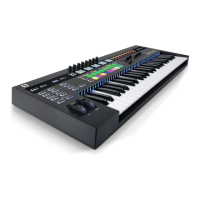9
Pattern
The next item in the Options menu is ‘Pattern’, which itself contains four sub-options: ‘Start Position’, ‘End Position’,
‘Direction’ and ‘Sync Rate’. Editing these settings alters the playback of Patterns in interesting ways (we recommend playing
around here to achieve ‘happy accidents’). Pattern changes will take effect when playback reaches the end of the Pattern.
The adjustable settings are as follows:
Tempo INCONTROL
Zones
Sequencer
LatchArp
Scales
Sessions
Patterns
Steps
Save
Duplicate
Clear
Grid
Options
Pitch Modulation
Octave
Transpose
Track
_
+
Templates
Expand
• Start Position - The rotary knob above ‘Start Position’ moves the start Step of the Pattern, changing Pattern length.
The pad for this Step will be lit yellow, to allow you to see where the start position is moving. If the Start Position
changes so Steps containing notes are no longer heard, these pads will light red.
• End Position - The knob above moves the end step of Pattern playback, changing the Pattern length. End Position
can come before the start position. If End Position changes so that Steps containing notes are no longer heard, these
pads will light red.
• Direction - This changes the course of Pattern playback. The following directions are available:
• Forward - As the default, ‘Forward’ shows a typical playback Pattern, which begins at the start Step (start
position) and moves to the end Step.
• Backwards - ‘Backwards’ means playback begins at the end position and step progresses to the start Step.
You could think of this as ‘reverse’.
• Ping-Pong - During the first phase, playback begins at the start position and progresses to the end position.
During the second phase, playback starts at the end Step and proceeds back to the start position. End Steps
are repeated.
• Random - The most experimental Direction option, this playback option continually selects Steps between the
start and end position in a random order, resulting in repeated notes and general chaos.
• Sync Rate - This changes the rate at which steps occur relative to the BPM (either internal or external) Choose
among the following musical time values:1/32 Triplet, 1/32, 1/16. Triplet, 1/16 (default), 1/8 Triplet, 1/8, 1/4 Triplet,
1/4 note values.
• Pattern Shift - This simultaneously nudges the start and end points of your pattern. A value between 0 and 15
shows how many steps you have shifted the pattern since it was first created.
Micro-steps
Each step of the sequencer features six smaller micro-steps for greater resolution of the sequencer. To access micro-steps,
in the steps view press the Options button. To add a note to a micro-step, choose a sequence step by pressing a pad. You
can then see the six micro-steps lit on the top row of buttons (above the faders) press and hold a micro-step button and play
keys to add these notes to that micro-step.
When you press a different step in the sequence the six micro-step buttons will change to show you which micro-steps have
a note assigned, brightly to show there’s a note, dimly to show that micro-step is empty.

